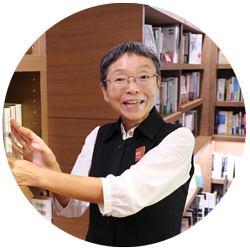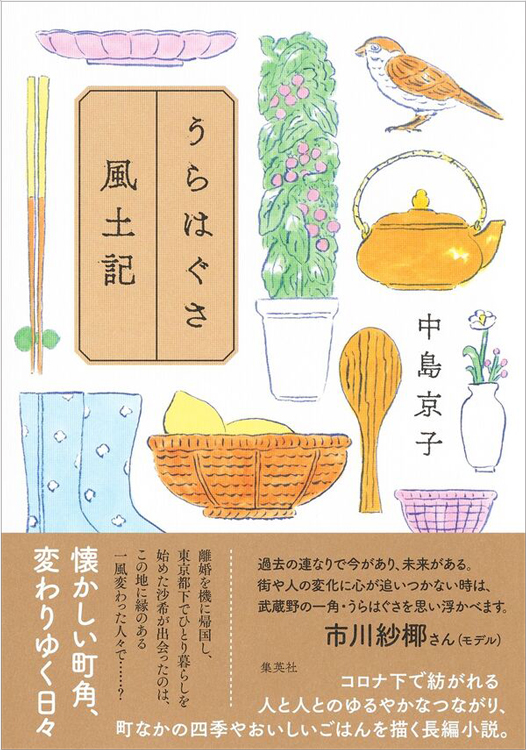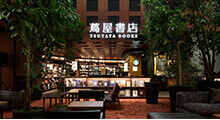[265th] Michiko Mamuro's bookshelf "Urahagusa Fudoki" by Kyoko Nakajima / Shueisha
Known as the "original charismatic bookseller," DAIKANYAMA TSUTAYA BOOKS, who recommends books in a variety of media including magazines and TV.
In this series, we take a peek into the "bookshelves" in the mind of our most popular concierge.
Please enjoy it along with his comments.
* * * * * * * *
"Urahagusa Fudoki"
Kyoko Nakajima/Shueisha
Click on the image to go to the purchase page.
Click on the image to go to the purchase page.
* * * * * * * *
Saki is 52 years old. After breaking up with her husband in the US and the department in California where she had been teaching for 20 years was closed, she received an offer to teach at her alma mater in Japan.
Returning to Japan for the first time in 30 years, she lives alone in her uncle's house (who is hospitalized in a hospital in Nagoya with dementia) in the "Urahagusa" district of Musashino, and deepens her relationships with the people around her. This area is a place that holds memories from her student days. But this is not the typical "good story of middle-aged people rebuilding themselves in the place of their youth."
This book is about intercultural and intergenerational exchange. It touches on a mountain of issues that are still lacking or not going well at all in Japan today, such as the problem of vacant houses (the sentence "800,000 houses in Tokyo" appears casually), labor (the sentence "800 million people will lose their jobs in 10 years" also appears casually), diversity, disappearing shopping districts, poverty and school lunches, and taxes that cannot be described in detail. What struck me the most was that this book is also a "story of war."
Masami Kameda, a first-year student who became Saki's student and is known as Marcy, takes part in a speech contest at the school festival. There are three contestants. Marcy is the last to take part, and her theme is "The History of the Urahagusa District." She collapses in the middle of her speech. She hyperventilates as she tries her best to convey the historical facts she has found out about what happened in the area and what the American architect who designed her favorite old lecture hall at the university did during World War II.
The first thing I thought about this scene was how America was able to leave behind such documents. In my opinion, it's a "pretty shocking story." But for the victorious nation, it may be a "calm, rational, and proud record." Either way, if it's not written down, it won't remain, and if it doesn't remain, it won't be passed down. It's quite difficult to suddenly go to war documents, so it's significant that the author, Kyoko Nakajima, has taken it up in her novel. Stories are also "written and left behind."
The film also depicts the situation in which, in the Reiwa era, the Tokyo Metropolitan Government suddenly gave the go-ahead for a road expansion plan that had been left abandoned for 50 years (the idea from the era of altimetric regrowth that said, why not just widen the roads and let cars drive on them?), and how, while the government is allowed to remain in limbo for half a century, when someone close to us dies, we have no choice but to decide within three months what to do with our money and our homes (the situation is called the ``consideration period''!).
Novels are also a kind of rehearsal for the reality that suddenly befalls us. The socially conscious (!) reading flavor slowly and deeply seeps into the reader, and the further appeal of this book is that it is a "story that can be put to use."
A shop is not only supported by the connection between the owner and the customer, but also by the street. When we think of life, we tend to think of work, private life, and human relationships, but I'm sure there are many people who feel that the physical objects of their rooms, houses, and gardens allow them to breathe easily. It's not enough to simply "last a long time." Metabolism is something that takes place so that we can continue to live vibrantly in the future!
Instead of just losing or letting go, there are good ways to leave things behind, pass them on, and put them away. For towns, homes, and life. That's the kind of story this is. Highly recommended!
Returning to Japan for the first time in 30 years, she lives alone in her uncle's house (who is hospitalized in a hospital in Nagoya with dementia) in the "Urahagusa" district of Musashino, and deepens her relationships with the people around her. This area is a place that holds memories from her student days. But this is not the typical "good story of middle-aged people rebuilding themselves in the place of their youth."
This book is about intercultural and intergenerational exchange. It touches on a mountain of issues that are still lacking or not going well at all in Japan today, such as the problem of vacant houses (the sentence "800,000 houses in Tokyo" appears casually), labor (the sentence "800 million people will lose their jobs in 10 years" also appears casually), diversity, disappearing shopping districts, poverty and school lunches, and taxes that cannot be described in detail. What struck me the most was that this book is also a "story of war."
Masami Kameda, a first-year student who became Saki's student and is known as Marcy, takes part in a speech contest at the school festival. There are three contestants. Marcy is the last to take part, and her theme is "The History of the Urahagusa District." She collapses in the middle of her speech. She hyperventilates as she tries her best to convey the historical facts she has found out about what happened in the area and what the American architect who designed her favorite old lecture hall at the university did during World War II.
The first thing I thought about this scene was how America was able to leave behind such documents. In my opinion, it's a "pretty shocking story." But for the victorious nation, it may be a "calm, rational, and proud record." Either way, if it's not written down, it won't remain, and if it doesn't remain, it won't be passed down. It's quite difficult to suddenly go to war documents, so it's significant that the author, Kyoko Nakajima, has taken it up in her novel. Stories are also "written and left behind."
The film also depicts the situation in which, in the Reiwa era, the Tokyo Metropolitan Government suddenly gave the go-ahead for a road expansion plan that had been left abandoned for 50 years (the idea from the era of altimetric regrowth that said, why not just widen the roads and let cars drive on them?), and how, while the government is allowed to remain in limbo for half a century, when someone close to us dies, we have no choice but to decide within three months what to do with our money and our homes (the situation is called the ``consideration period''!).
Novels are also a kind of rehearsal for the reality that suddenly befalls us. The socially conscious (!) reading flavor slowly and deeply seeps into the reader, and the further appeal of this book is that it is a "story that can be put to use."
A shop is not only supported by the connection between the owner and the customer, but also by the street. When we think of life, we tend to think of work, private life, and human relationships, but I'm sure there are many people who feel that the physical objects of their rooms, houses, and gardens allow them to breathe easily. It's not enough to simply "last a long time." Metabolism is something that takes place so that we can continue to live vibrantly in the future!
Instead of just losing or letting go, there are good ways to leave things behind, pass them on, and put them away. For towns, homes, and life. That's the kind of story this is. Highly recommended!
* * * * * * * *
(Redirects to Yahoo! Shopping)

DAIKANYAMA TSUTAYA BOOKS Literature Concierge
Michiko Mamuro
【profile】
"The original charismatic bookseller" who recommends books in various media such as magazines and TV. Has serials in magazines such as Fujingaho and Precious. Active as a book critic, her paperback reviews include "The Pale Horse" (Agatha Christie/Hayakawa Christie Bunko), "Motherhood" (Minato Kanae/Shincho Bunko), "The Snake Moon" (Sakuragi Shino/Futaba Bunko), and "Staph" (Michio Shusuke/Bunshun Bunko).
























